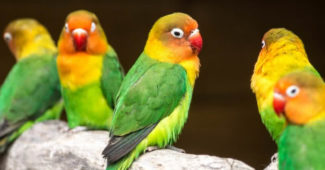Observing bird species with naturally vibrant colors is truly awe-inspiring. This stunning characteristic helps them stand out from predators and communicate to predators that they are not a safe choice for consumption. There are many reasons why different bird species continue to showcase beautiful and colorful feathers, from mating to recognizing members of their own species to diverting predators.
Below are the top ten bird species whose feathers are the most colorful, exquisite, and peculiar, making them some of the world’s most colorful birds.
10Kingfisher
Interestingly, the blue feathers down the back of a kingfisher are actually brown. However, they appear as bright blue due to the phenomenon of structural coloration. The cyan and blue barbs of the kingfisher’s striking plumage contain spongy nanostructures that reflect light differently and produce a different set of colors through tiny variations in the structure of the barbs.
9Peacock
Javanese peacocks and peahens have similar coloring. During courtship, Indian and green peacocks unfurl their long trains, up to 7 feet wide, and have iridescent feathers in a scale pattern. Ocelli that resemble shining eyes adorn the train of peacocks. These characteristics serve the purpose of impressing and attracting female peafowls.
Top 10 Most Colorful Animals In The World
8Crimson Rosella
Northern Queensland Crimson Rosellas are smaller and darker than their southern counterparts. Meanwhile, Adelaide Rosellas have a mix of yellow and reddish-orange coloration. Young Crimson Rosellas have blue cheeks and green-olive or yellowish-olive feathers, with some red in certain areas. It takes over 15 months for young birds to develop their adult plumage.
7Mandarin Duck
The Mandarin duck is a bird known for its vibrant appearance. It has a greenish-black forehead, a purple crest at the back, and creamy white sides on its head. They also have a chestnut patch below their eyes. Their upper breast is maroon, while their lower and belly are white. During courtship, they perform a unique routine involving bobbing heads and raising their crest.
They are sometimes called love ducks because people believe they can enhance and attract love if they keep a sculpture of these ducks at home. Since they mate with one partner for life, Mandarin ducks symbolize the importance of love and commitment.
6Toucan
Toucans spend most of their lives in the rainforest canopies and rarely venture down to the forest floor. Interestingly, their beaks have a rapid blood flow system that helps regulate their body temperature. Toucans even sleep on their beaks during cold nights to conserve body heat.
5Spangled Cotinga
The Spangled Cotinga is a unique and visually striking bird found in the tropical rainforests of Central and South America. These lively creatures have distinct features, such as long fleshy wattles, bulbous crests, and Elvis-like pompadours. Their brightly colored feathers, ranging from electric blue to deep purple and screaming orange, play an essential role in sexual selection.
Some species, like the Andean Cock-of-the-Rock, Turquoise Cotinga, and Banded Cotinga, have evolved a range of vibrant hues to attract mates. Interestingly, some cotingas have developed feather structures with feather protein molecules on a nanoscale level, which scatter light to produce visible colors for sexual signaling.
4Gouldian Finch
The Gouldian Finch boasts eye-catching features with its purple chest, green wings, yellow belly, and turquoise headbands. These colors come from various genetic and cellular processes, with their diet being a significant factor. Both male and female Gouldian finches have the same color distribution, but males are brighter.
Finches get red and yellow colors from eating grass seeds, especially sorghum. Their structural blue is due to light’s reflection through nanostructures in their feathers. Green and purple colors combine blue structural colors and carotenoid pigments, while black feathers come from melanin pigment produced by skin cells during feather growth. Their vivid coloration is significant in mate selection and reproduction.
3Quetzal
The females have a similar coloration to the males, but their plumage is dimmer. The red near their chests is much duller, and their heads are edged with green or grey-colored. These birds prefer to perch high up in the tree canopy rather than appear on the forest floor.
2Lilac-Breasted Roller
They typically inhabit sub-Saharan Africa and the southern Arabian Peninsula, preferring open woodland and savannah. Their acrobatic aerial displays during the breeding season and are known for their fearlessness when hunting. They use techniques like swooping down on their prey and using their wings to disorient them before eating.
Related Articles
1Scarlet Macaw
They typically reside in the rainforest and prefer to live in areas with dense vegetation to camouflage themselves. When predators attempt to attack a scarlet macaw, they quickly fly away in a flock. Their diverse feather colors disrupt the predator’s focus, making it difficult for them to catch one. This allows the scarlet macaws to use their striking appearance as a survival technique.




